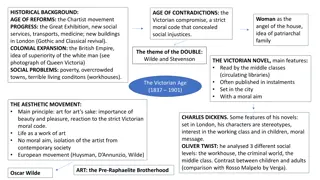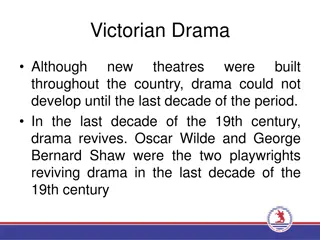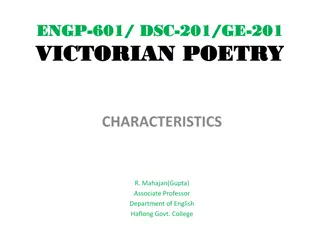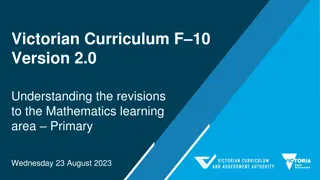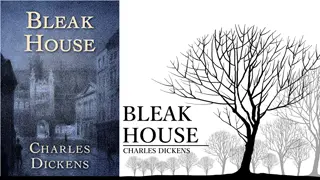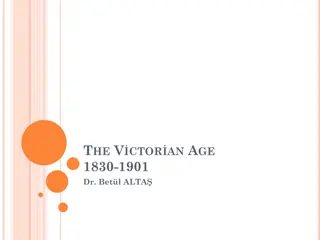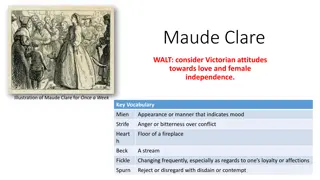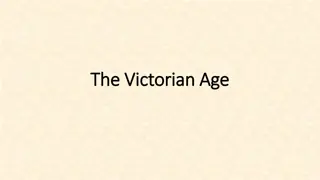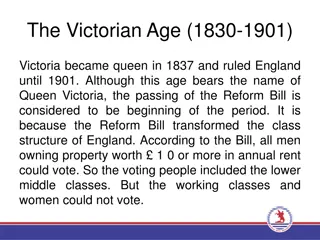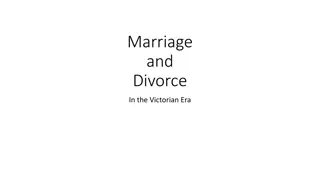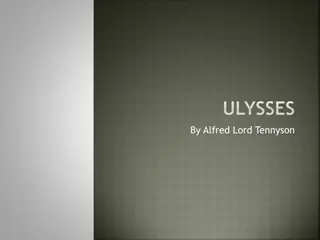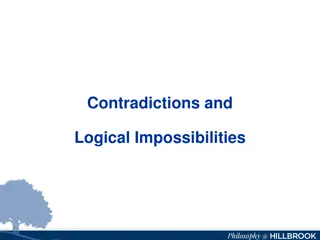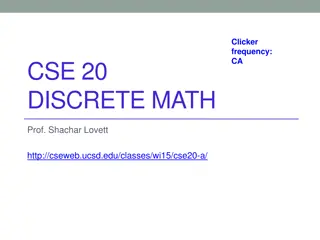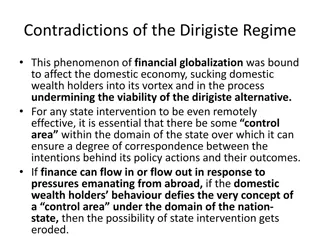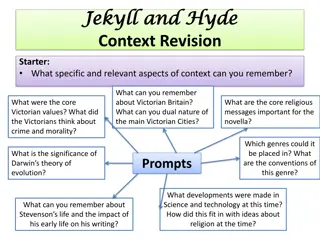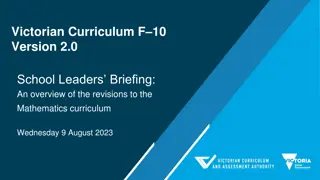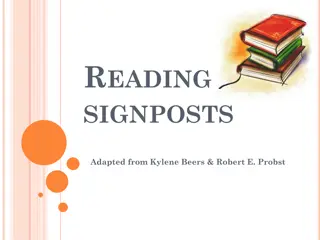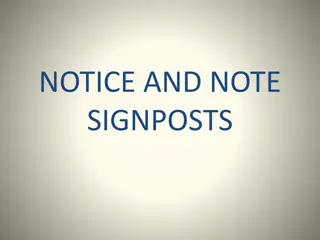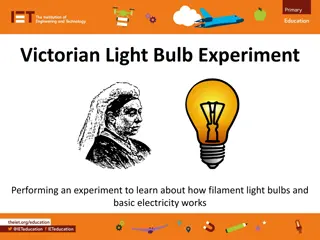The Victorian Age: A Era of Contrasts and Contradictions
The Victorian Age, epitomized by Queen Victoria's reign, was a time of significant diversity, compromise, and contradictions. It was characterized by values, social reforms, and a blend of high and popular culture. The era, encapsulated by Dickens' words, was a period of contrasts - from wisdom to foolishness, hope to despair. Queen Victoria's life, marriage to Albert, and impact as an iconic figure are highlighted. It was an age of both repression and progress, reflecting a transition towards modernity.
Download Presentation

Please find below an Image/Link to download the presentation.
The content on the website is provided AS IS for your information and personal use only. It may not be sold, licensed, or shared on other websites without obtaining consent from the author. Download presentation by click this link. If you encounter any issues during the download, it is possible that the publisher has removed the file from their server.
E N D
Presentation Transcript
The Victorian Age The Age and Its Double
Lesson Outline Queen Victoria. Some common ideas about the age. Periodization: Conventional subdivisions. Diversity. Compromise. Contradictions. Victorian values. Poverty, unrest and reform Change and progress The Woman Question. Science. Religion High culture and popular culture. Architecture Art. The genres. The canon. The construction of Victorianism Modernist attitudes regarding the Victorian age and their influence on its construction.
It was the best of times, it was the worst of times, it was the age of wisdom, it was the age of foolishness, it was the epoch of belief, it was the epoch of incredulity, it was the season of Light, it was the season of Darkness, it was the spring of hope, it was the winter of despair, we had everything before us, we had nothing before us, we were all going direct to heaven, we were all going direct the other way - in short, the period was so far like the present period, that some of its noisiest authorities insisted on its being received, for good or for evil, in the superlative degree of comparison only. Charles Dickens, A Tale of Two Cities
Queen Victoria, an Icon Victoria b. 1819. German family: House of Hanover . Father Duke of Kent (George III s son) d. 1820 Victoria heir presumptive. Her uncle, King William IV, had no heirs. Educated for the throne in native German and English, by mother (House of Saxe-Coburg) Came to the throne 1837 (coronation 1838) 1840 married Albert Saxe-Coburg and Gotha, a German prince, her cousin. Image of bourgeois happiness. A strong morality and family values, in contrast to the sexual, financial and personal scandals that had been associated with previous members of the House of Hanover and which had discredited the monarchy. Lived at Buckingham Palace Had 9 children. 42 grandchildren. The grandmother of Europe. Albert died 1861. Mourned for 10 yrs. No public appearances. Victoria wore black ever since. Albert Memorial. Later established close relationship with a Scottish manservant, John Brown. Maybe secret marriage. 1876 Empress of India. Under Prime Minister Disraeli s influence, expansionist foreign policy. Golden Jubilee (1887). Diamond Jubilee (1897): parade with representatives of all colonies. Died 1901. Longest reigning British sovereign.
An Age of Contrasts Named by extrinsic facts. Single label for a long and heterogeneous age. No clear-cut features to characterize it. Actually, an age of contrasts Faith in reason vs fantasy, sensationalism, the gothic Earnestness vs nonsense, fun Moralism vs unbridled sexuality, erotic lit., the nude Patriarchal repression of women vs emancipation, the New Woman, women s achievements in lit. Victorianism is all but stuffy. It contains the seeds of modernity.
The Victorian compromise The coexistence of contrasting realities: prosperity and progress on the one hand, and poverty, ugliness and injustice on the other. Ethical conformism vs corruption Moralism and philanthropy vs capitalistic greediness. , Private life vs public behaviour. Victorian culture was dominated by a capitalist economy and a patriarchal structure which however were subtly undermined and challenged. The Victorians are interesting not only because they are complicit with the ideological systems they often thought themselves resisting, but because they often tried to be oppositional and were remarkably alert to the constraints that language and conventions imposed on them (George Levine)
Victorian Values Earnestness. Self help. Respectability: a mixture of both morality and hypocrisy, severity and conformity to social standards. Puritanism, all sorts of taboos, even linguistic. Influence of Queen Victoria. Family values.
Periodization Victoria s reign: 1837-1901 Victorian Age: 1830 1890 1830-1848 Ruthless Industrial Revolution; laissez-faire policies; move to the cities; growth of slums; social unrest, Chartism, 1832 Reform Act; Marx & Engels, cf Dickens 1848-1870 Wealth and well-being; triumphalism (Victorian compromise), Great Exhiition 1851, Empire, Expansion, Identification of middle-classes with monarchy. The Crimean war 1870-1890 Military and economic set-backs. Uncertainty. Loss of continental power status. Queen Victoria s Jubilee. The Boer war. 1890 -- decadence, fin de si cle. Debunking of earnestness. Art for art s sake movement. Aestheticism.
Change in the social sphere Social change Reform Bill 1832 Democratic process: (partial extension right of vote to middle classes) Chartism (Radical movement; male suffrage): failed but Created a framework for future working-class organisations. Repeal Corn Laws (free trade, anti-protectionism) Poor Laws 1834 Growth of cities, new cities. Growth of slums and dire poverty The Industrial Revolution meant that the balance of power shifted from the aristocracy, whose position and wealth was based on land, to the newly rich business leaders. Education Acts extended compulsory education. Literacy
Urbanisation On the home front the Industrial Revolution accelerated the migration of the population from country to city. The result of this movement was the development of horrifying slums and cramped row housing in the overcrowded cities. Misery and distress among the working classes. The new urban conditions created a lot of health problems. Whole families were often crowded in single rooms, where lack of hygiene occasionally led to cholera. By 1900 80% of the population lived in cities,-the poor living further away from the city core. Suburban rail transit
Advances in Technology Mining (coal) Industrial production Rise of capitalism. Benefits for middle classes (heating, lighting etc.). Exploitation of minors and women. Transportation. High-speed printing. Communications (telegraph; photpgraphy)
Problems and events of the early Victorian period Age of extreme poverty and social unrest. The establishment of Poor Houses. The Chartist movement began in 1839 with demands for electoral reform and universal male suffrage. The movement was taken over by radical reformers and was dealt with very harshly by the authorities. The Anti Corn Law League was another voice for social reform. They advocated total free trade, but it was not until 1846 that the Corn Laws were completely repealed 1846 Irish Famine Marx and Engles were inspired by the conditions of England. It seemed as if a revolution would break up, any moment. Dickens, Gaskell, Kingsley portrayed the poverty and unrest of this era .
From Friedrich Engels The Condition of the Working Class (1845). 1 Every great town has one or more slum areas into which the working classes are packed. Sometimes, of course, poverty is to be found hidden away in alleys close to the stately homes of the wealthy. Generally, however, the workers are segregated in separate districts where they struggle through life as best they can out of sight of the more fortunate classes of society. The slums of the English towns have much in common the worst houses in a town being found in the worst districts. They are generally unplanned wildernesses of one- or two-storied terrace houses built of brick. Wherever possible these have cellars which are also used as dwellings.
2 These little houses of three or four rooms and a kitchen are called cottages, and throughout England, except for some parts of London, are where the working classes normally live.These streets themselves are usually unpaved and full of holes. They are filthy and strewn with animal and vegetable refuse. Since they have neither gutters nor drains, the refuse accumulates in stagnant, stinking puddles. Ventilation in the slums is inadequate owing to the hopelessly unplanned nature of these areas. A great many people live huddled together in a very small area, and so it is easy to imagine the nature of the air in these workers' quarters
Events of the mid-Victorian period (1848-1870) The Great Exhibition. Improvements in working conditions (Factory Acts), education and health. The Crimean War The Indian Mutiny and transfer of India from the East India Company to the Crown.
The Great Exhibition 1851 Great Exhibition marked the triumph of the middle classes, advances in technology and imperial expansion. Victoria's consort, Prince Albert, was the main backer of the 1851 Great Exhibition. This was the first "world's fair", with exhibits from most of the world's nations. The exhibition was held in Hyde Park, and the showpiece was the Crystal Palace, a prefabricated steel and glass structure like a gigantic greenhouse, which housed the exhibits.
The Crimean War Overseas, England became involved in the Crimean War (1854, a contest between the major European powers and Russia for influence over territories of the declining Ottoman empire. Military incompetence. Riots against the war and parliamentary interrogations. See poem"The Charge of the Light Brigade", by Alfred Tennyson. First of the modern wars: technical changes tactical uses of railways, telegraph Live war reporting: public kept up-to-date. Documented by photographs Establishment of more humaneand modern nursing practices under the influence of Florence Nightingale, the "Lady with the Lamp". Use of anesthetics.
The Indian Mutiny 1857 India until 1858 was governed by the Est India Company with government assistance. The Mutiny in the Hindu army was sparked off by religion causes. The army rebelled and massacred many British officers, administrators, and families. The rebellion led to the dissolution of the East India Company in 1858. It also led the British to reorganise the army, the financial system and the administration in India. It was the beginning of the Raj and of the Indian empire. Queen Victoria became Empress in 1876. .
Unprecedented change in the condition of women. At the beginning of the century, women had no legal existence, no right to property, no guardianship over children, no right to education. Debate over a woman s sphere, Angel in the house ideology. Woman idealized: Angel in the house The New woman Woman reified: Rise of prostitution Erotic literature Painting of nudes Yet, social movements and legal reform secured many rights for women: Factory Act Married women s property Act, Education extended to women. 1848 Queen s College. The suffrage movement
Leisure and Tourism Technology changed leisure in Victorian Britain Influence of railways and of the invention of the bicycle. On working-classes Outings in the country-side Bank holidays made escapes to seaside resorts (Blackpool, Brighton) possible. Development of seaside resorts. Holiday packages: a day at the seaside (train and meal) On the middle-classes mass tourism. Thomas Cook, first travel agent (1841) Organized trips to the Continent. Travellers cheques. The Music Hall. Theatres The amusement-pier at the seaside resort.
Science Progress in science and technology (steam, electricity, medicine, sanitation). Mostly scientific knowledge had the purpose of supporting a theological vision of nature. Science had to prove the existence of God. Development of some specific scientific areas had a great impact on culture, religion and society: Geology Biology Anthropology
Lyell and Darwin Lyell s Principles of Geology prove that research on transformations of the globe contradict the creationism of the Scriptures. Tennyson In Memoriam George Eliot Darwin s natural observations on the Beagle and the publication of The Origin of Species (1859) introduce evolutionism, which goes against the Bible also in the field of biology.
Anthropology Anthropology affirms itself as the modern science of man in the Nineteenth cent John Lubbock: Notions of primitive people (prehistoric man compared to populations living in colonized countries) Idea of bringing civilisation to primitive people used in order to justify economic expansion, colonialism. Edward Burnett Tylor s Primitive Culture introduced the ethnological concept of culture: there is an essential uniformity among different people but there are various stages of development and evolution. Frazer, The Golden Bough The knowledge of primitive cultures helped prove that England had reached the highest point of civilisation.
Victorian Ecocriticism Ruthless expansion, exploitation of the soil, inconsiderate building, transformation of inner cities. Many Victorian writers show an awareness of the degradation the physical environment was undergoing. (Dickens, Hopkins. Economic policies of laissez-faire, colonialism and capitalism increased rural poverty and hunger and exacerbated famine.
Architecture Because of great fire of London (1666), the image of London is mostly Victorian. Economic and social development matched by great architectural development. Various revivals, but especially gothic revival. Monumental buildings: Covent Garden. Victoria and Albert Museum Royal Albert Hall Albert Memorial
Art Much indoctrinating, anecdotical painting with a moral message. Showed how ordinary people lived. Pictured the condition of Victorian society. Often too sentimental. A visual record of an era before photography was used to document reality (photography, however, sed as a model for painting) . Celebration of the city and of a changing landscape. Main focus: the world of bourgeois Britain: family portraits and paintings to decorate their houses. Great market for artists who opened their studios to the public and became rich. Even the great Romantic painter William Turner Turner became interested in contemporary technology and painted bridges, trains, ships etc. documenting progress in an expressive way. (Frith Ramsgate Sands and Turner Rain, Steam and Speed
Revolutions in the Victorian Art Scene The Pre-Raphaelite Brotherhood. Founded in 1848 by William Holman Hunt. Rossetti, Millais. Painters and poets. Refusal of academic painting. Go back to Italian Quattrocento. Magazine The Germ The first avantgarde movement. Arts and Crafts Movement (1860-1910) Inspired by Ruskin. A reaction to the ugliness of industrialized England. Design. Decorative objects for homes, including wallpaper, textiles, furniture and stained glass. William Morris. Liberty s Department Store Kelmcott Press Victoria and Albert Museum
Religion Contested from the right: Tractarianism; Oxford Movement; Newman HG.M.Hopkins Contested from the left. Dissent (Evangelical movement, Methodists. Anti-slavery movement. Child Labour). Put into question by recent scientific theories and especially by Darwin (although he never excluded the possibility of a higher purpose behind the order of nature).
Relevant Topics in Literature Residual Romanticism in the novel and in poetry On the whole an engaged literature responding to relevant issues; Imaginative responses to industrialisation and urbanisation; representation of social upheaval. Literature reflects the crisis of faith and religious belief. Takes the place religious teaching. Denounces sins; offers moral lessons. A destabilized age reflected in a literature weighed with doubts, angst and contradictions A literature challenging ways to deal with morally and socially repressed topics; experimental Complicit with Capitalism, Colonialism and the rise of the empire
The Great Victorian Novel Major achievement of the age. Vital. Comprehensive. Portrays various aspects of society. Expression of the middle-classes and of their values. Realism. Self-referentiality. But also desire to improve, to correct. Didactic. Engaged. Yet complicit with the ssytem. Mixes sentimentalism with humour. Henry James defined Victorian novels: Loose baggy monsters : 3 vols. Instalments. Cliff-hangers. Cf. Soap operas. Circulating libraries. Family reading.
Major Novelists Charles Dickens evolution from optimism to pessimism. William Thackeray. The Brontes, a literary myth. Elizabeth Gaskell George Eliot Anthony Trollope Thomas Hardy George Gissing Rudyard Kipling
Unconventional genres Even realistic novels contaminated by other genres. The irrational. A literatre devoid of high seriosness ,withot a prpose, intended for entertainment The supernatural, the uncanny, the gothic. (Bram Stoker, Le Fanu, Stevenson, Wilde). Psychological enqiry. Sensationalism. Erotic literature Detective novels. (Dickens, Collins, Conan Doyle) Science fiction. (Wells, Butler) Fantasy, nonsense. (Lewis Carroll, Esdward Lear) Children s Literature
Questioning Victorianism Samuel Butler. The Way of All Flesh The Aesthetic Movement. Walter Pater Oscar Wilde
Poetry Residual lyricism ( Romanticism). More innovative than other genres. Contamination with other genres and epistemic fields. Tennyson / Science Arnold: philosophy Hopkins / theology, linguistics Robert Browning: theatre (dramatic monologue); detective novel The Ring and the Book E. Barrettt Browning: Aurora Leigh: a novel in verse. Pre-Raphaelites: fantasy, fairy - tales. Swinburne / erotica
The Victorian Sage Age characterized by great prose works addressing varios problems and criticizing the age and its shortcomings. Carlyle, on the effects of industrial capitalism. Ruskin against machines, industry and the evils of British society. Newman on drying up of religiosity Matthew Arnold on absence of ideals and hypocrisy (philistinism) J. Stuart Mil, on absence of freedom and on the sbjection of women.l
Journalism The extension of British journalism in the Victorian age has been the result, largely, of technology resulting in cheapness and of ability to obtain news in increasing quantity and speed, and, in some respects, with greater accuracy. Freedom of press; little censorship. Multiplication in the number of daily and weekly journals Increased circulation (by 100 times, over the century) Speed printing, cheap paper made from wood pulp led to low prices. Advertising brought prices down. Speed: Distribution (railways) Use of telegraph
Various constructions of Victorianism Early constructions underline Realism Referentiality Character Moral intention Earnestness,Work ethic Prudishness, repression Bourgeois values Patriarchism, capitalism, Imperialism Hypocrisy
Images of the Victorian Age What Victorians told us e.g. Ruskin agst. Evils of industrialisation and materialism Arnold: Philistinism J.S. Mill, The Subjection of Women What Modernists told us Strachey: Eminent Victorians Woolf (read from Orlando)
From Virginia Woolfs Orlando chap. V The great cloud which hung, not only over London, but over the whole of the British Isles on the first day of the nineteenth century stayed, or rather, did not stay, for it was buffeted about constantly by blustering gales, long enough to have extraordinary consequences upon those who lived beneath its shadow. A change seemed to have come over the climate of England. Rain fell frequently, but only in fitful gusts, which were no sooner over than they began again. The sun shone, of course, but it was so girt about with clouds and the air was so saturated with water, that its beams were discoloured and purples, oranges, and reds of a dull sort took the place of the more positive landscapes of the eighteenth century. Under this bruised and sullen canopy the green of the cabbages was less intense, and the white of the snow was muddied. But what was worse, damp now began to make its way into every house damp, which is the most insidious of all enemies, for while the sun can be shut out by blinds, and the frost roasted by a hot fire, damp steals in while we sleep; damp is silent, imperceptible, ubiquitous. Damp swells the wood, furs the kettle, rusts the iron, rots the stone. So gradual is the process, that it is not until we pick up some chest of drawers, or coal scuttle, and the whole thing drops to pieces in our hands, that we suspect even that the disease is at work.
Continued Thus, stealthily and imperceptibly, none marking the exact day or hour of the change, the constitution of England was altered and nobody knew it. Everywhere the effects were felt. The hardy country gentleman, who had sat down gladly to a meal of ale and beef in a room designed, perhaps by the brothers Adam, with classic dignity, now felt chilly. Rugs appeared; beards were grown; trousers were fastened tight under the instep. The chill which he felt in his legs the country gentleman soon transferred to his house; furniture was muffled; walls and tables were covered; nothing was left bare. Then a change of diet became essential. The muffin was invented and the crumpet. Coffee supplanted the after-dinner port, and, as coffee led to a drawing-room in which to drink it, and a drawing-room to glass cases, and glass cases to artificial flowers, and artificial flowers to mantelpieces, and mantelpieces to pianofortes, and pianofortes to drawing-room ballads, and drawing-room ballads (skipping a stage or two) to innumerable little dogs, mats, and china ornaments, the home which had become extremely important was completely altered.
Continued Outside the house it was another effect of the damp ivy grew in unparalleled profusion. Houses that had been of bare stone were smothered in greenery. No garden, however formal its original design, lacked a shrubbery, a wilderness, a maze. What light penetrated to the bedrooms where children were born was naturally of an obfusc green, and what light penetrated to the drawing-rooms where grown men and women lived came through curtains of brown and purple plush. But the change did not stop at outward things. The damp struck within. Men felt the chill in their hearts; the damp in their minds. In a desperate effort to snuggle their feelings into some sort of warmth one subterfuge was tried after another. Love, birth, and death were all swaddled in a variety of fine phrases. The sexes drew further and further apart. No open conversation was tolerated. Evasions and concealments were sedulously practised on both sides. And just as the ivy and the evergreen rioted in the damp earth outside, so did the same fertility show itself within. The life of the average woman was a succession of childbirths. She married at nineteen and had fifteen or eighteen children by the time she was thirty; for twins abounded. Thus the British Empire came into existence; and thus for there is no stopping damp; it gets into the inkpot as it gets into the woodwork sentences swelled, adjectives multiplied, lyrics became epics, and little trifles that had been essays a column long were now encyclopaedias in ten or twenty volumes.
What have we inherited from the Victorians? Modern cities. Established industrialism (factory and manufacturing life had come to stay); 'multiple national identities' (the separate traditions of England, Wales, Scotland and Ireland) opening the way for a multiracial society. A divided public culture. Middle-class taste drove the increasing commercialisation of publishing, painting and architecture, Largely working-class readership depended on hack writers, producers of penny dreadfuls and gallows speeches who sold in their hundreds of thousands.


